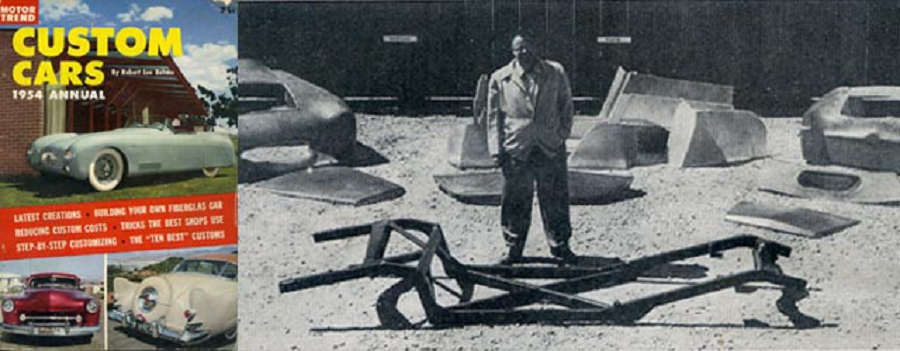
Note: This is the third in a series of stories about the fiberglass sports cars that appeared in the 1954 Custom Cars book by Motor Trend. Click here to review each of these stories on Forgotten Fiberglass.
————————–
Hi Gang…
In the third part of this article, they reviewed the history of Woodill Wildfire – starting with the introduction of their first car in late 1952 (a modified Glasspar G2 body) and into the debut of their second design – a design created by Bill Tritt of Glasspar for Woody Woodill – which occurred in the July 17 1953 issue of Motor World Magazine.
What’s neat about this article, again, is the timing of its review. Here they are reviewing the history of these early fiberglass sports cars and it’s not even three full years later. I wish I was that close to the “Real McCoy” in time – that would make research so much easier 
Next, it names three key individuals that helped him run it: S. Howard Miller, Robert “Bob” Conner, and Harold “Shorty” Post. All three are documented in historical articles, but it’s nice to see the history of Woodill Wildfire tightly written in a article from the time – 1953/1954. Finally, the article discusses some of the reasons why they changed the Wildfire from its original design to the new one – a completely original design by Tritt for Woodill.
The write-up on the Woodill below seems to have occurred in late summer / early fall of 1953. I mention this because they outline that a new design has just been announced by Woodill and that would place it smack in the center of ’53. By 1954 when this article came out they were already in production and had sold many of these cars.
It’s also interesting to note that in the article both Shorty Post and Bill Tritt were involved in the chassis design. The Woodill Wildfire frame was a near knock-off of the MAMECO frame built and sold by Woodill directly. Ed Martindale from MAMECO confirmed (personal interview several years ago) that Bill Tritt designed the original frame built by MAMECO, and the article points out that, again, Bill Tritt made improvements in the chassis design that were implemented in the Wildfire frame.
The result of these changes to chassis designed yielded what may have been the best frame yet designed for a “build it yourself” fiberglass sports car in the 1950s – bar none!
This article also talks about what happened to the original idea of the Wildfire becoming a Willys based sports car, and why it didn’t happen. The detail in this article is simply amazing for the time – 1954. A fiber-gem for each of us to treasure.
All in all, this is a great review of the history of Woody Woodill and the Woodill Wildfire sports cars done close in time to when it happened. How could we ask for more?
So away we go….
1954 Custom Cars Trend Book 109
Woody Woodill & The Woodill Wildfire
One of the most interesting new designs in the Fiberglas sports car field has just been announced by the Woodill Motor Company of Downey, California. Their car, which is called the Wildfire, has been in production for over a year. The model which was recently unveiled is the company’s second design and replaces the previous model. The fact that the new design is a beautifully contoured body styling, even more delightful than the early model, should be enough to make the new Wildfire a potential sales leader.
The car is a product of the Woodill Motor Company which was begun by B.R. “Woody” Woodill two years ago while he was a new-car dealer. Woodill realized that many advantages could be obtained by combining a sports car body with stock Detroit parts.
Woodill brought such outstanding automotive experts as S. Howard Miller and Robert “Bob” Conner into his organization, sold his new-car dealership and plunged into the ground work involved in beginning a new company.
He chose Willys’ parts for his sports car because of their excellent record for rugged manufacture and wear. He made arrangements with the factory to supply motors, axles and drive components while his own company planned to build a special sports car chassis. Along with “Shorty” Post, a well known free-lance automotive engineer, the Woodill Staff began chassis development.
It was at this point that Woodill decided to separate the body manufacture from the chassis construction and assembly. He planned to produce the frames and under-body components at the factory as well as actual assembly, but he decided to turn the production of the Fiberglas body over to more specialized hands. He chose the Glasspar Company because of their outstanding record.
Glasspar modified their standard design to give the Wildfire a different look, but the transformation was not unique. Even while Woodill was developing the frame for his first body, he was planning ahead to the time when he could develop a unique body style.
From the beginning, the Woodill engineers placed great emphasis on the chassis design and by this time Post, along with Glasspar’s Bill Tritt, has come up with a sturdy box-like frame with outriggers, which would fit all Willys’ parts into a neat, sports car package.
The first cars were made using this frame. Minor improvements were made as production moved along but the rugged construction was proving practical. A speed-up seemed assured when the sudden announcement of a consolidation between Willys and Kaiser occurred.
In a sense, it left the Woodill group out in the cold. Woodill could still produce the Wildfire using the Willys’ parts but his work threatened to conflict with the Darrin K-F sports car. Woodill pulled out and decided that this was the time to cut back on production and bring out the new body design which he’d planned.
He shut down his production line, gambled for a time on the back orders which piled up, and commissioned Bill Tritt of Glasspar to design a new body. The new body was to be original in every respect, yet it was to be capable of mounting to any Detroit chassis as well as to the Wildfire frame.
In a sense it was a brave move for the company to make, cutting back on production at a time when they had begun to show a profit, but there actually was little choice in the matter. The announcement of the new body however, has stirred up such excitement in automotive circles that “Woody’s” gamble seems to have been well worth the effort.
The clean continental flair of Bill Tritt’s design has caught the imagination of the American taste. The saucy high rear fenders, combined with the smooth-contoured front air scoop, should make the Wildfire a very popular car.
The new body will continue to be fabricated at the Glasspar plant. They will produce from the Woodill mold and in a sense will function as a subsidiary of the Woodill plant. The Wildfire design will be exclusive with the Woodill Motor Company. It will not be related to the Glasspar car in either design or construction. Since the two companies are not related, a strong rivalry actually exists and the two designs will compete on the market. “The construction standards will be equally high on both autos,” says Bill Tritt, “for Glasspar intends to become a fabricating vendor as well as producer and we can only become this through workmanship.”
The original frame with the outriggers, which had been designed for the Willys’ version, could not be used with the new body. It was necessary to design a completely new frame for the job. The new Wildfire frame, designed by Bill Tritt, is constructed of sturdy square steel tubing.
At first the cross members were all made of the same square tubing, but the front cross member has been replaced with a stock Ford section. The other cross members are still made from the square tubing and are proving to be adequate. The reason for the change in the front was due to recent production experiments. It was found that the front transverse spring and rigid axle could be installed with greater efficiency when stock shackle mountings were used.
At present, the Wildfire frame is being constructed to take stock ’39 to ’41 Ford parts without changes. The frame is designed so that axle, wheel, and spring components between ’39 and ’48 can be used, although the factory recommends ’39 parts. The reason is due to the fact that preliminary tests have shown that the ’39 tread and track are very nearly perfect for sports car usage. Other years’ parts require changes to conform to those widths.
All frame construction and installations are done at the Downey plant. The factory, which occupies a new concrete building just off busy Firestone Boulevard, in Downey, houses all of the Wildfire production stages except body fabrication. At the factory the employees build frames, assemble kits and completed cars.
There are three distribution methods in effect at this time:
* The Wildfire may be purchased assembled and ready to roll either from a local dealer or direct from the factory
* Or it may be purchased in two different kits for home construction.
—The completed car sells for $3445, FOB Downey
—The basic kit, which sells for $875, includes the factory assembled body and all parts needed for installation on the automobile frame.
It is not necessary to purchase the Wildfire frame and underbody assembly with the kit. In fact, the factory does not recommend purchase of the under-assembly kit unless the Wildfire frame is purchased. The assembly is constructed to fit the Wildfire frame only. At the present time the easiest method of construction a Wildfire at home is to purchase a complete kit with the frame and under-assembly included . Too much unnecessary work is involved when a stock frame is used. The savings are not practical. Considerable time is saved through the purchase of the frame and under-assembly. Though it adds $325 to the charges, it is worth the cost.
A complete kit including frame, body, under assembly, and windshield brackets costs $1,200 FOB Downey, California. This price includes federal excise tax, but California state taxes, which are paid only by California residents, are not included. The kit can be shipped anywhere in the United States for less than $100. Since it is necessary to use stock ’39 parts on the Wildfire frame, the simplest solution to the problem of obtaining these parts is to purchase an old ’39 car or a ’39 frame and wheel assembly at a local wrecking yard.
Most Ford parts will fit the Wildfire frame without alteration but a few parts require changes before they can be used. The driveshaft must be shortened 12 inches and the end re-splined. The reason for the change: the engine is mounted 12 inches further back than a stock car. This change in engine placement is part of the reason the Wildfire has superior handling characteristics, but it also means that the radius rods and tie rods must be cut to fit the new mountings.
No other alterations are necessary. It is believed, although not yet proven, that the installation of other makes of engines on the frame would be just as simple. The Ford manual lists adapter plates for all major engines so that other makes can be fitted to the Ford rear end with only a few changes.
The Woodill Motor Company plans to make available such items as the shortened drive shaft and new rods in its deluxe kits at a later date. They also plan to provide factory upholstery, but at the moment these items must be supplied by the purchaser. It seems probable however, that those who have purchased earlier kits, may take advantage of factory changes when they occur.
Summary:
What an excellent article and a glimpse smack dab in the middle of the golden age of building your own sports car. And…it provides insight into the another giant of ‘glass from the ‘50s – Woodill Wildfire.
But wait – there’s more! This is just the third article in a series that appeared in the 1954 Custom Cars Trend Book Annual #109. We have many more articles to go….and miles to drive before we sleep
Hope you enjoyed the story, and until next time…
Glass on gang…
Geoff
——————————————————————-
Click on the Images Below to View Larger Pictures
——————————————————————-
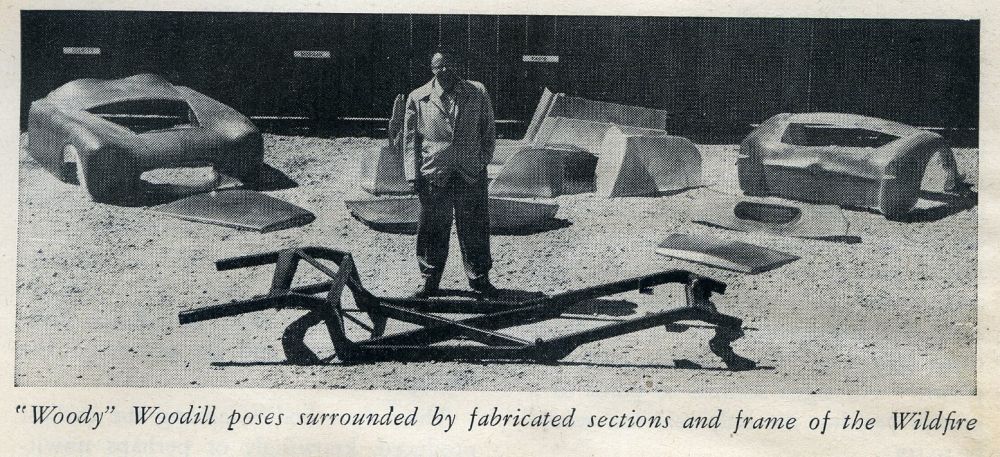
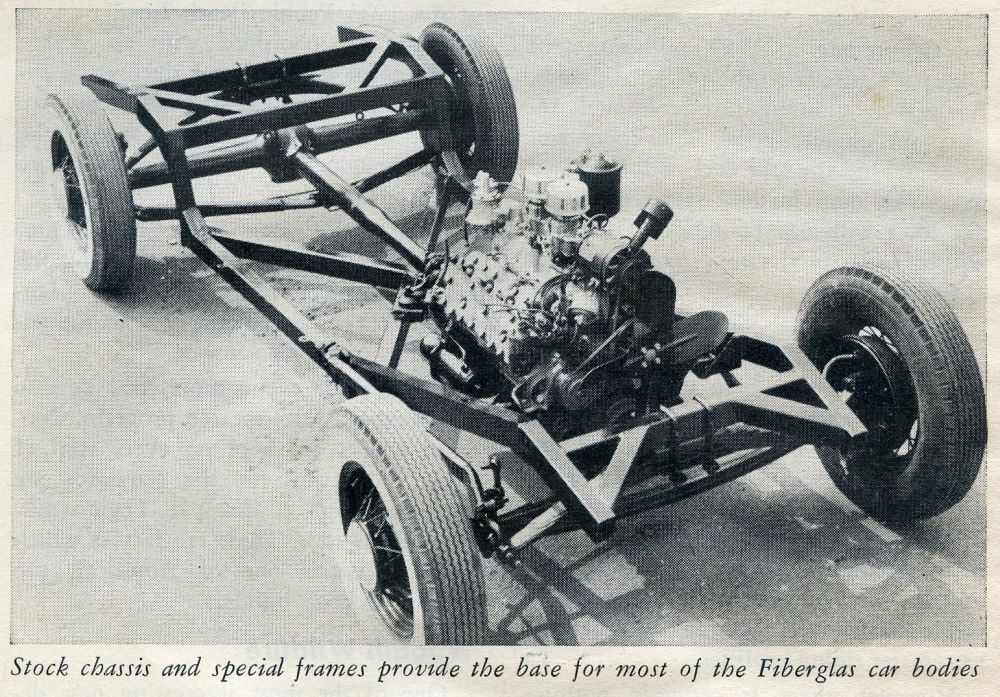
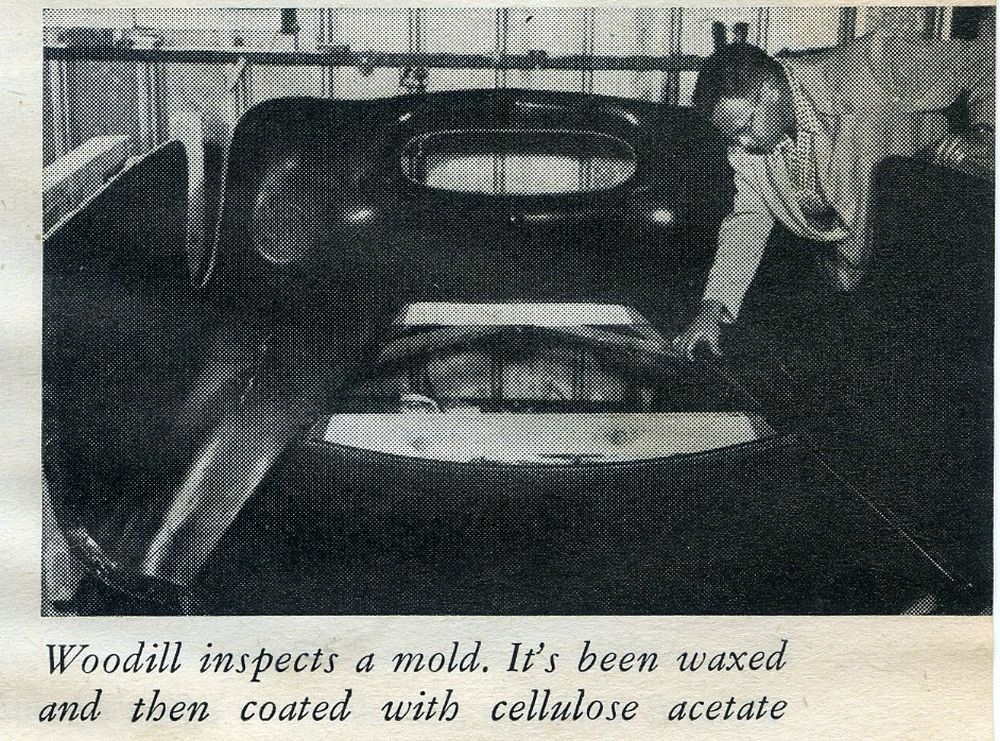
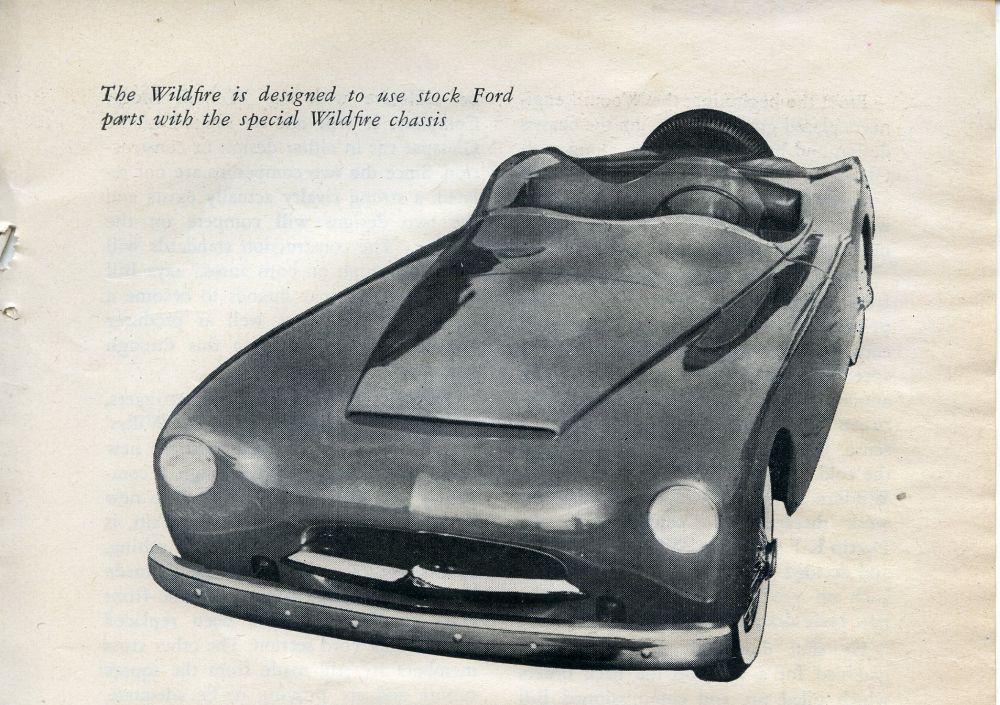
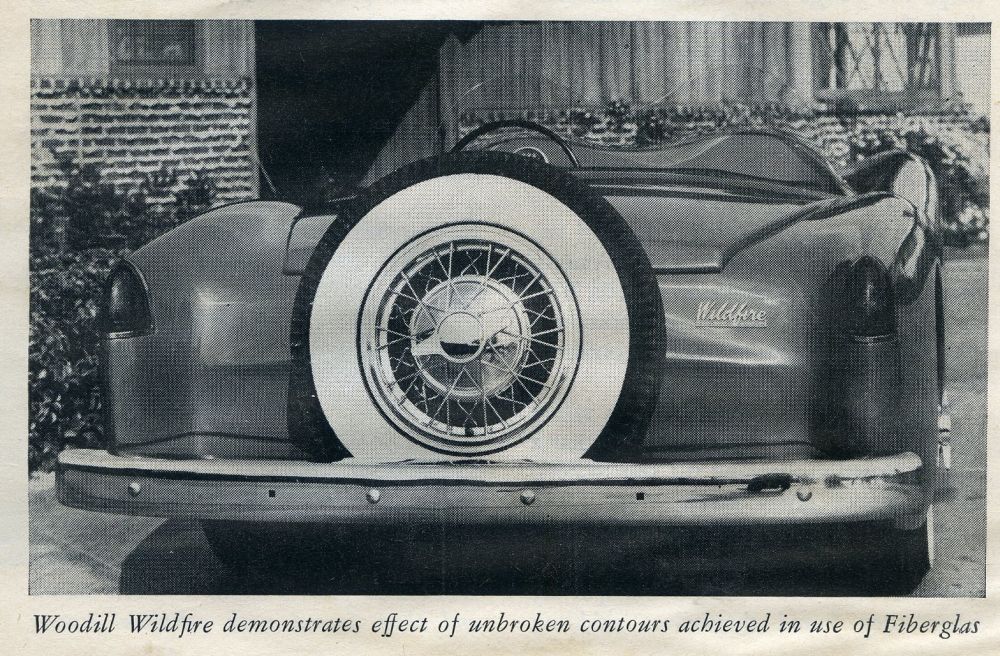
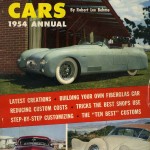
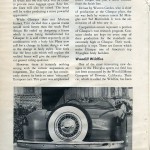
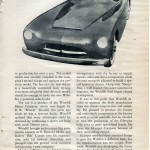
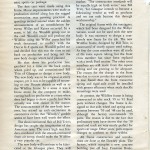
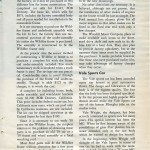
does anyone know what bumpers and grill was used in the wildfire
Love that frame! Woody was a great pioneer in the fiberglass car world, it took alot of guts to sell his business and promote his own car.